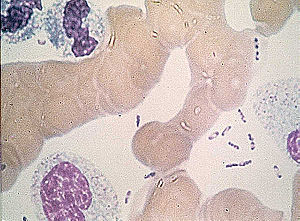
Wayson stain
Encyclopedia

Methylene blue
Methylene blue is a heterocyclic aromatic chemical compound with the molecular formula C16H18N3SCl. It has many uses in a range of different fields, such as biology and chemistry. At room temperature it appears as a solid, odorless, dark green powder, that yields a blue solution when dissolved in...
, ethyl alcohol-phenol
Phenol
Phenol, also known as carbolic acid, phenic acid, is an organic compound with the chemical formula C6H5OH. It is a white crystalline solid. The molecule consists of a phenyl , bonded to a hydroxyl group. It is produced on a large scale as a precursor to many materials and useful compounds...
microscopic
Microscopic
The microscopic scale is the scale of size or length used to describe objects smaller than those that can easily be seen by the naked eye and which require a lens or microscope to see them clearly.-History:...
staining procedure. It was originally a modified methylene blue stain used for diagnosing bubonic plague
Bubonic plague
Plague is a deadly infectious disease that is caused by the enterobacteria Yersinia pestis, named after the French-Swiss bacteriologist Alexandre Yersin. Primarily carried by rodents and spread to humans via fleas, the disease is notorious throughout history, due to the unrivaled scale of death...
. With this stain, Yersinia pestis
Yersinia pestis
Yersinia pestis is a Gram-negative rod-shaped bacterium. It is a facultative anaerobe that can infect humans and other animals....
appears purple with a characteristic safety-pin appearance, which is due to the presence of a central vacuole.
Wayson stain is used along with the Giemsa
Giemsa stain
Giemsa stain, named after Gustav Giemsa, an early German microbiologist, is used in cytogenetics and for the histopathological diagnosis of malaria and other parasites.-Uses:...
and Wright's
Wright's stain
Wright's stain is a histologic stain that facilitates the differentiation of blood cell types. It is used primarily to stain peripheral blood smears and bone marrow aspirates which are examined under a light microscope...
stains to rapidly detect potential biowarfare attacks It has also been investigated as a possible cheaper and faster way to detect melioidosis
Melioidosis
Melioidosis is an infectious disease caused by a Gram-negative bacterium, Burkholderia pseudomallei, found in soil and water. It is of public health importance in endemic areas, particularly in Thailand and northern Australia. It exists in acute and chronic forms. Symptoms may include pain in...
. It is a useful alternative to the Gram
Gram staining
Gram staining is a method of differentiating bacterial species into two large groups ....
or Loeffler’s Methylene Blue stains, especially for detecting Yersinia enterocolitica
Yersinia enterocolitica
Yersinia enterocolitica is a species of gram-negative coccobacillus-shaped bacterium, belonging to the family Enterobacteriaceae. Yersinia enterocolitica infection causes the disease yersiniosis, which is a zoonotic disease occurring in humans as well as a wide array of animals such as cattle,...
which is often found in contaminated food

